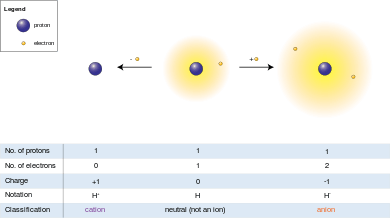Hydrogen ion
A hydrogen ion is created when a hydrogen atom loses or gains an electron. A positively charged hydrogen ion (or proton) can readily combine with other particles and therefore is only seen isolated when it is in a gaseous state or a nearly particle-free space.[1] Due to its extremely high charge density of approximately 2×1010 times that of a sodium ion, the bare hydrogen ion cannot exist freely in solution as it readily hydrates, i.e., bonds quickly.[2] The hydrogen ion is recommended by IUPAC as a general term for all ions of hydrogen and its isotopes.[3] Depending on the charge of the ion, two different classes can be distinguished: positively charged ions and negatively charged ions.
Cation (positively charged)
A hydrogen atom is made up of a nucleus with charge +1, and a single electron. Therefore, the only positively charged ion possible has charge +1. It is noted H+.
Depending on the isotope in question, the hydrogen cation has different names:
- Hydron: general name referring to the positive ion of any hydrogen isotope (H+)
- Proton: 1H+ (i.e. the cation of protium)
- Deuteron: 2H+, D+
- Triton: 3H+, T+
In addition, the ions produced by the reaction of these cations with water as well as their hydrates are called hydrogen ions:
- Hydronium ion: H3O+
- Zundel cation: H5O2+ (named for Georg Zundel)
- Eigen cation: H9O4+ (or H3O+ •3H2O) (named for Manfred Eigen)
Zundel cations and Eigen cations play an important role in proton diffusion according to the Grotthuss mechanism.
In connection with acids, "hydrogen ions" typically refers to hydrons.

Hydrogen atom (center) contains a single proton and a single electron. Removal of the electron gives a cation (left), whereas addition of an electron gives an anion (right). The hydrogen anion, with its loosely held two-electron cloud, has a larger radius than the neutral atom, which in turn is much larger than the bare proton of the cation. Hydrogen forms the only cation that has no electrons, but even cations that (unlike hydrogen) still retain one or more electrons are still smaller than the neutral atoms or molecules from which they are derived.
Anion (negatively charged)
Hydrogen anions are formed when additional electrons are acquired:
- Hydride: general name referring to the negative ion of any hydrogen isotope (H−)
- Protide: 1H−
- Deuteride: 2H−, D −
- Tritide: 3H−, T −
Uses
Hydrogen ions drive ATP synthase in photosynthesis. This happens when hydrogen ions get pushed across the membrane creating a high concentration inside the thylakoid membrane and a low concentration in the cytoplasm. However, because of osmosis, the H+ will force itself out of the membrane through ATP synthase. Using their kinetic energy to escape, the protons will spin the ATP synthase which in turn will create ATP. This happens in cellular respiration as well though the concentrated membrane will instead be the inner membrane of the mitochondria.
Hydrogen ions concentration, measured as pH, is also responsible for the acidic or basic nature of a compound. Water molecules split to form H+ and hydroxide anions. This process is referred to as the self-ionization of water.
References
- "Hydrogen ion - chemistry". britannica.com. Retrieved 18 March 2018.
- due to its extremely high charge density of approximately 2×1010 times that of a sodium ion
- Compendium of Chemical Terminology, 2nd edition McNaught, A.D. and Wilkinson, A. Blackwell Science, 1997 ISBN 0-86542-684-8, also online Archived 2005-12-12 at the Wayback Machine